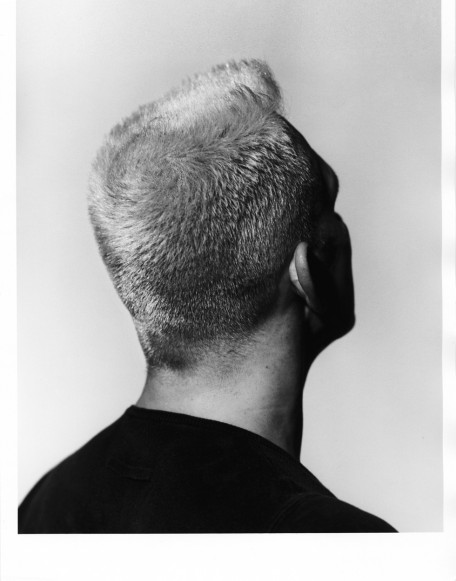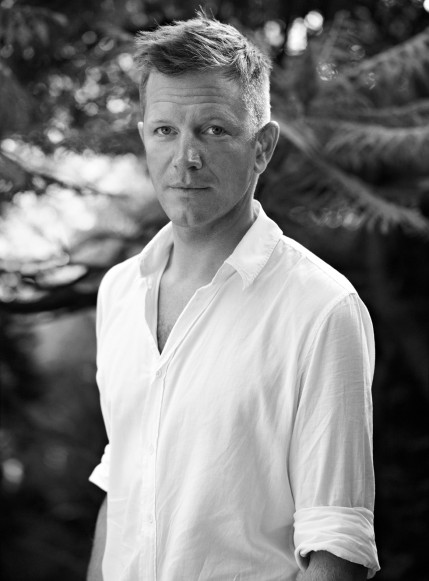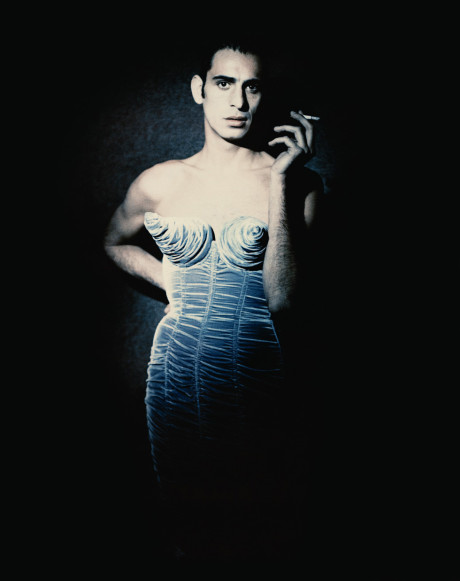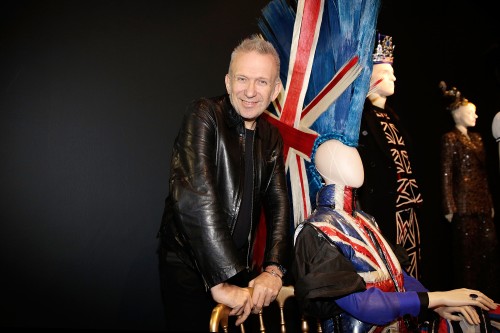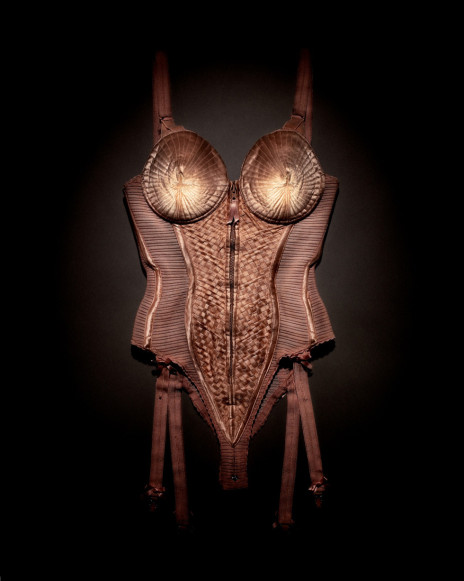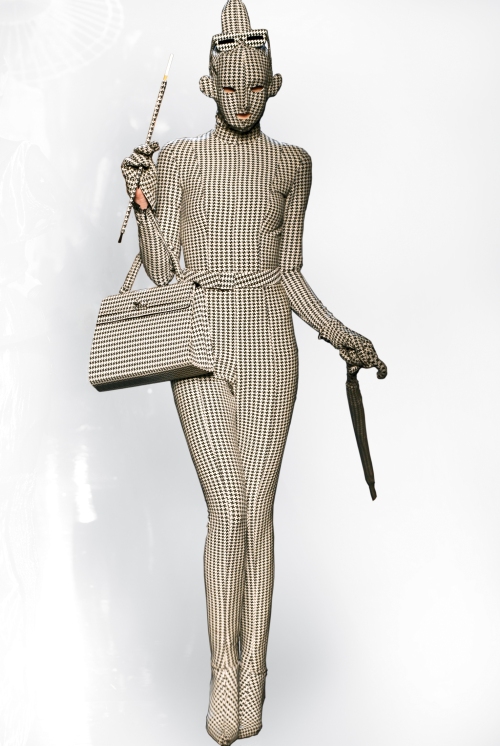The Fashion World of Jean Paul Gaultier: From the Sidewalk to the Catwalk / Interview with Curator Thierry-Maxime Loriot
Read it on HUNGER TV
Already visited by more than one million people worldwide, The Fashion World of Jean Paul Gaultier: From the Sidewalk to the Catwalk finally arrives at the Barbican Centre in London. Monsieur Gaultier attended yesterday’s inauguration of the very first exhibition on his oeuvres and after an interview, conducted by Exhibition Curator Thierry-Maxime Loriot, he officially opened the Barbican Art Gallery’s doors to his world, where almost four decades of couture become the very fabric of what a dream is made of. Hunger TV peeked inside the exhibition, featuring stage costumes designed for Madonna and Kylie Minogue, pieces created for the films of Pedro Almodóvar [The Skin I Live In] and Luc Besson [The Fifth Element], and Gaultier’s rich collaborations with renowned photographers such as David LaChapelle, Miles Aldridge, Peter Lindbergh and Herb Ritts. In this magnifique and overwhelming French Revolution of couture, music, sketches and videos, we turned to Mr. Loriot, former model turned curator, who guided us through Gaultiers’ vision and explained how he managed to translate it into a theatrically-staged exhibition.
Instead of a fashion retrospective the exhibition, conceived in 2011 by the Montreal Museum of Fine Arts, is an installation featuring eight thematic sections, from Punk Cancan to The Boudoir and Urban Jungle. “An exhibition is not to be something boring. It has to be alive and my dream” said the French couturier and having Nana on display, his childhood’s teddy bear, allows us to make an intimate connection with his imagination as an enfant, when the self-taught designer used to spontaneously play, and unconsciously create his future. Dressing up Nana in 1957 with colorful punk hairdos and the first prototypes of the cone-bra corsets may look like a game that any creative little boy would play but, unlike the others, le petit Gaultier would grow up to see Nana’s paper conic bra turning into the i-conic bustier Madonna wore during her Blond Ambition Tour in 1990. His fantasies, and creations, became bigger than reality and though he remembers his first show as a catastrophe, the 150 haute couture and prêt-à-porter ensembles showcased at the Barbican are pieces of love and history still impacting culture and society.
“Making the final selection was the biggest challenge I faced as a curator” tells me Mr. Loriot on Gaultier’s archives. “Plus, the exhibition is traveling but there is something great about it. It’s adapted differently depending on the venue and public. In Madrid there was a section about Spain, focusing on all of Gaultier’s collaborations with Almodóvar for example. We also developed new galleries in the process to show pieces we could not feature before, like the Muses section. It’s very generous from him to lend these pieces for such a long time and share them with the world”. After ten years working as a model Mr. Loriot coordinated the Yoko Ono and John Lennon Bed-In For Peace exhibition in Montreal. When Nathalie Bondil, Chief Curator of the museum, called him to discuss a fashion exhibition, there was only Gaultier on his mind. “He is the only contemporary fashion designer whose influence can be seen in so many different things from furniture to music videos and films. I had an incredible archive to work with, it felt like a dream and it’s fun how people think of him only for Madonna.”
It is important to point out Gaultier’s humble upbringing, marked by the open-minded personalities of his mother and grandmother, and not only because “too much comfort is not good for creativity” but most importantly for his early understanding of women’s shapes, tricks and transformations through clothing. This will provide him with that irreverent vision and sensibility necessary to become the enfant terrible we know. Who else could have broken the rules in the pioneering and established world of Parisian couture if not someone with a cheeky attitude and a big passion? As French couturiers where dictating the rules on how to make a woman look chic, Gaultier redefined this notion and succeeded in showing us that collections inspired by rabbis, gypsies, the exotic Frida Khalo and the sparkling Les Folies-Bergère were indeed très chic.
The Barbican towers, striped for the occasion with the same Gaultier’s signature motif of the French sailors’ sweaters he wore as a boy, welcomed him to London, a city he took a lot of inspirations from, especially in the early 70s. “Maybe it is because you live on an island that you are not contaminated!” joked Gaultier during the interview, talking about his love affair with London and British subculture. If in France fashion was banal according to him, in England the punk movement and the work of Vivienne Westwood and Malcom McLaren was fun, exciting and an invitation to not be afraid of recreating that same feeling through extravagant mises-en-scène. Multiethnic models of all ages and cultural backgrounds started walking and interacting with the audiences on his catwalk. Denim, tattoos, red afro hairstyles and most of all gender bending became for him elements to glorify during the shows. Whatever was it that society tried to ignore or considered taboo on the sidewalk, Gaultier celebrated it on the catwalk. Differences become beautiful and thanks to him, like-minded and revolutionary personalities could not resist a French style that was finally embracing different types of people. Madonna felt powerful and unashamed to show both her masculinity and femininity and in the exhibition, we also find out that someone well-known for his resistance to mass culture like Kurt Cobain was really wearing Gaultier.
“As you can see, London has so many different influences on the exhibition” continues Mr. Loriot, “he always reinterpreted elements of the pearly queens and kings in his work. It is not only about punk there is also Boy George, Amy Winehouse and David Bowie. London is the city where he first saw the stage version of The Rocky Horror Picture Show in 1973 and he was obsessed with those red lips on the posters. You can also find his spitting image in the Eurotrash section and it’s absolutely fabulous”.
More than terrible Gaultier is still an ‘enfant’ when it comes to look at the world with no filters. You instantly recognize this attitude in his funny and outspoken persona, or in the way he runs up and down the catwalk after a show with the spontaneity of a child. This is because his intention was not to merely provoke the public but to be a voyeur, inspired by what people see even when sometimes “what we see it’s not real but it’s inspiring as well”. Gaultier’s avant-garde shows remind of the theatrical ones that Alexander McQueen will later put on, but their interpretation of “dramatic” does not translate in the same way. There is a joie de vivre in Gaultier’s world and the colorful dramatisation of his couture is meant to provoke a contagious and liberating feeling in everyone who’s watching. Through his work he effortlessly demands our attention because, as a consumed voyeur, he’s aware of our desire for those women full of character, the seducing tailored silhouettes and the intoxicating colors and designs. In the alternate reality he creates, beauty is like a persuasive burlesque performer who keeps our excitement growing as we forget all inhibitions.
Mr. Loriot cannot define beauty because there are so many different types. When Gaultier dresses someone like Beth Ditto, who is not necessarily a fashion standard, he presents her in a way that makes her beautiful and it’s true. She has this energy and everyone wants to be around her. It is the same thing when he shows people from different backgrounds and I think it’s very generous to give this opportunity. It almost educates society to see something that is different”.
Visiting the exhibition means facing Gaultier’s aesthetic fixations and inspirations. As you walk through it, encountering Odile Gilbert’s sublime sculptural headdresses and wigs and even talking mannequins, with the help of holograms projected onto their faces, memories emanates through this rebellious and innovative way of making couture. The memory of Fellini’s Satyricon and the Broadway show Nine inspired by his film 8½, where Gaultier was struck by a scene in which actresses wore salmon underwear and corsets. The memory of Jacques Becker’s Falbalas is palpable in the section called Muses, expanded for the Barbican to feature models, musicians and performers that have inspired Gaultier from Frida Khalfa, Naomi Campbell, Kate Moss to Erin O’Connor and Dita Von Teese who looked like a butterfly closing his Spring/Summer 2014 show. Religious iconography, corsetry, S&M and trompe l’oeil all dissolve through the different rooms blending in a patchwork of everything but always showing a new precise and distinctive facet of his inspirations.
What does Mr. Loriot wish to all the visitors coming to the Barbican? “I hope they understand that there is a strong social message in Gaultier’s world. The exhibition is also a unique opportunity to see couture up close, you don’t get to do it even if you attend couture shows. Some dresses took 1600 hours of work and when they’re on stage for two minutes you don’t have a direct interaction with them. Every piece of his work still looks so modern and fresh because he broke a lot of taboos and offered through fashion a very open vision of society. Everybody is welcomed in his world and just like Gaultier I’m hungry to discover things I don’t know about.”
Art should be about being revolutionary and without being a chronological installation, The Fashion World of Jean Paul Gaultier is more than a visual journey, it’s a cultural experience through time.”Timeless” is an overused adjective when describing fashion styles and yet when you walk out the Barbican, it will be the first one crossing your mind. Gaultier’s universe is a magical source of inspiration for any creative who, just like him, is looking for true uniqueness in a world where being yourself is still the ultimate form of censorship. When a couture creation triggers a reaction that has got more to do with who we are first, rather than the artistry it took to produce it, then this creation becomes a meaningful work of art that goes beyond time and fashion. Gaultier’s bride closing the Fall/Winter 2013-14 haute couture show, wearing trousers and layers of fluttering tulle on a compass-drawn silhouette, is another provocative reflection and statement on society that continues to inspire [him] and being inspired by his bizarre creativity. “I don’t like dreams or reality. I like when dreams become reality because that is my life”, so don’t be surprised if during your visit you happen to see a little boy, wearing a marinière sweater, running through the exhibition’s rooms holding Nana in his hand.
‘The Fashion World of Jean Paul Gaultier: From the Sidewalk to the Catwalk’ runs from 9 April 2014 – 25 August 2014 Barbican Art Gallery.
‘In Conversation: Jean Paul Gaultier’ the legendary and newly appointed International Vogue Editor Suzy Menzkes in an intimate on-stage discussion with fashion’s l’enfant terrible. 15 April 2014 at 7pm – Barbican Hall
Tickets and Events Programme here

